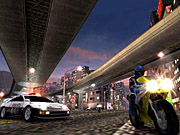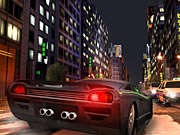Midnight Club II Designer Diary
We start our series of diaries for Rockstar's upcoming street racing game.
The original Midnight Club was one of the stronger titles available for the PlayStation 2 when the system first launched. The street racing game was developed by Angel Studios, a veteran developer whose portfolio runs the gamut from creating CG for early Sega CD and Saturn games to working on the early Midtown Madness games. A lot has changed for Angel and the PlayStation 2 since the original game shipped. The sequel, Midnight Club II, finds Angel Studios, now known as Rockstar San Diego following its recent acquisition by Rockstar games, at the helm again. The game aims to top its predecessor with enhanced graphics, tighter gameplay, and an online multiplayer mode. Over the course of the next few weeks, we'll be hearing from different members of the game's development team, who'll be looking at different aspects of the game's development. This week we'll hear from level designer Marc Fredrickson, who'll be talking about building the cities in the game. For more on the cities of Midnight Club II, check out our
The Cities of Midnight Club II, Part I: The Building Process - 02/21/03
By Marc Fredrickson Level Designer, Rockstar
The philosophy of building a city is to make it fun first. These days, a lot of companies are stuck on creating replicas of real cities, focusing on insignificant details that add nothing to the gameplay. We tried this years ago and quickly learned it was not fun. As a result, we are more concerned with making a fun race rather than with which building is on what corner. At 180 miles per hour it's all a blur anyway! The cities in Midnight Club II are built for racing.
Using Maya as an example, we start by creating a blocked-out primitive version of the city for the designers to play. After many rounds of revisions, and once we are happy with the layout and the gameplay, we break the cities up into roads, intersections, and blocks to begin building out the more detailed versions.
Each city features a dozen or so distinctive landmarks, and these are used as the central focal points of the levels. Racers can get their map orientation by getting to know the landmarks. Also, each city map has a number of unique neighborhoods, distinguished by their own lighting, layout, terrain, and appearance. The geometry is modeled so that every store looks completely different.

Each city lends itself to a different style of racing, so the game really changes from level to level. There is a natural variety in the types of races for each city. Los Angeles is a learning experience, since it's where you start the game. You get introduced to the vehicle controls and learn to master a city that is more open with wider streets and clear shortcuts. Paris is your introduction to more technical driving. The streets in Paris are not laid out in a grid--you have to learn to handle a very unpredictable network of tight streets. Tokyo is all about breaking the sound barrier. The massive highways, wide-open elevated train tracks, and large grid of downtown streets lend themselves to races with the fastest vehicles in the game, which are the fastest vehicles in any game, for that matter. In Tokyo, technical driving and flat-out speed culminate in the most insane racing experience you have ever had.
Designing the cities for speed was key. We want the races to flow and keep the pace as fast as possible. For example, we do things like place alleys strategically to give players the ability to make quick path choices at high speeds. A lot of planning goes into making the cities navigable at high speeds. But it is important to note that the sense of speed is very important as well. We achieve this in Midnight Club II by designing elements like narrow streets, small neon lights, bridges, overpasses, and detailed streets. All of these things whir by you clearly, thanks to the smooth frame rate, creating a visually stunning sense of real speed. The feeling of speed is crucial--it is one thing to see your speedometer clocking 200 miles per hour, but it is something else to really have the sensation of traveling at that velocity.

Due to the huge amount of research, planning, and testing that went into making the cities in Midnight Club II navigable and fast to race in, each city took more than six months to build. There are well over a million polys per city. More than 80 miles of roads can be found in each city, but that is just the streets on the map. When you take into account all of the shortcuts, jumps, parking garages, and tunnels, the number of raceable square miles is impossible to precisely measure. Also, there are more than 8,000 destructible props, like light poles and garbage cans, placed throughout the environments to make the races even more fun and lifelike.
Got a news tip or want to contact us directly? Email news@gamespot.com
Join the conversation